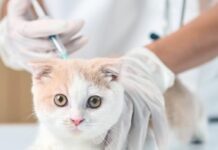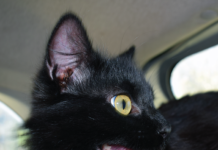Sure, those clumps in the kitty litter are stinky. But thats no reason to act like theyre radioactive.
At least thats what I used to tell my human officemate, James Richards, DVM, here in the Cornell Feline Health Center. Then the official feline at the center – thats me – paid a visit to the so-called Camp Thyroid in the Cornell University Hospital for Animals. What I learned about clinical treatments for hyperthyroid disease – and about a certain by-product from the cats at Camp Thyroid – would set your Geiger counter a-ticking.
The campers looked just like any others on visitors day – snoozing in their bunks, batting a ball around, or listening to the radio – but they werent there for the recreation. Camp Thyroid at the Cornell Universitys Hospital for Animals, as well as similar facilities at other large veterinary hospitals around the country, is a place for cats to receive treatment for over-active thyroid glands.
That lifesaving treatment – a quick injection – follows days of tests by the internal-medicine doctors. Then the cats get to hang around for about 10 days because they are – dare I say it -radioactive.
Welcome to Camp Thyroid
The head counselor at this special camp is a radiologist named Nathan Ned Dykes, DVM. Hes a genial man with a badge on his chest to show how much radiation hes exposed to each month (usually no more than the background levels we all get from living on Earth) and I listened up when he talked about thyroid disease.
Hyperthyroidism begins with too much thyroid hormone being produced in the thyroid glands in the neck, and we see it mostly in older cats, and less often in dogs. Among cats, hyperthyroidism is the second most prevalent hormone disorder, after diabetes, Dr. Dykes says. We look for signs like weight loss, even when the cat is eating well, thirst and excessive urination, rapid heart rate and high blood pressure, and abnormal liver function.
Diagnosis: Hyperthyroidism
Any of those signs alone might indicate other diseases, according to Dykes, so blood tests are performed to trace the problem to overactive thyroid glands. If its merely hyperthyroidism – it could be cancer, but only about two percent of the glands checked each year are malignant – then there are three options for treatment.
Drug treatment is one option, with a medicine called Tapazole, to prevent synthesis of thyroid hormone. Cats will need the drug for the rest of their lives and about 30 to 40 percent of patients do experience side effects, Dr. Dykes explains, so some owners consider surgery.
Surgical removal of abnormal thyroid tissue, either in one gland or both, is another option, Dr. Dykes says, noting that some cats have stray bits of thyroid tissue elsewhere in their bodies that the gland removal can miss.
Radioiodine, the third option, is the way most people are treated, and it works very well in cats. I have successfully treated cats as old as 18 and 19. The costs are comparable for any of the treatments – drugs over the long term, surgery, or radioiodine – at about $1000 to $2000, depending on the hospital.
Before radioactive iodine is administered, I learned, a veterinarian will check for other medical disorders, such as advanced liver disease, severe heart disease or cancer in the intestines. Additional diseases must be treated before any type of therapy for hyperthyroidism can begin. But if its a go, then a measured dose of Iodine-131 is obtained from a nuclear pharmacy.
The radioisotope of iodine, which is dissolved in a saline solution, is injected subcutaneously (under the skin) into loose tissue over the back and is immediately absorbed into the blood. Then the medicine finds its way, via the blood, to the abnormal tissue in the thyroid glands.
Search and Destroy
The radioiodine is selectively absorbed by the abnormal tissue and incorporated there, Dr. Dykes explained. The radioactivity kills the abnormal cells or damages their DNA so they cant replicate. Hormone levels drop to – or below – normal. Then, as the pituitary gland senses lowered hormone levels, it signals the remaining normal tissue in the thyroid glands to produce the appropriate amount. Full recovery takes a few weeks to a few months. After that, the cat should be set for life.
So you can send the lucky kitty home the same day, right, Doc? Not so fast, Dr. Dykes told me. Theres that little matter of residual radioactivity. Radioiodine has a half-life of eight days, which is pretty short compared to some radioactive elements that can take thousands of years to decay into harmlessness, but precautions are still necessary.
It takes 10 to 12 days for the radioactive iodine to reduce to levels mandated by the state health department, before we can send the cat home. Even then we dont want a cat that has just had radioiodine sitting on the lap of a pregnant woman or sleeping with children for the next couple weeks, he explained to me.
Hence, Camp Thyroid, where the living is easy. If campers dont like the music Dr. Dykes plays on the radio, their humans can provide cassette tapes of favorite tunes or messages recorded in a familiar voice. He can even be persuaded to bring back kitty bags of roast turkey from the college cafeteria, and the toys these felines get to play with are some of the coolest around.
Cleanup Crew
Then theres the litter box clean-up service at Camp Thyroid, which takes us back to where my tale began. It seems that residual radioactivity has to go somewhere, and out it comes – in the cats urine. Clump by radioactive clump, the litter is carefully removed and stored for three months, until the radioactive reaches background levels. (Both the university and the state health department have very strict rules for the safe handling and disposal of radioactive wastes of all kinds, and kitty litter isnt the strangest thing they monitor.) Finally, the clumps are deemed safe for disposal in a landfill dump.
So thats what I learned at Camp Thyroid. No, I dont glow in the dark and neither did the happy campers. Yes, Doc Richards, its time to clean my litter box again.



